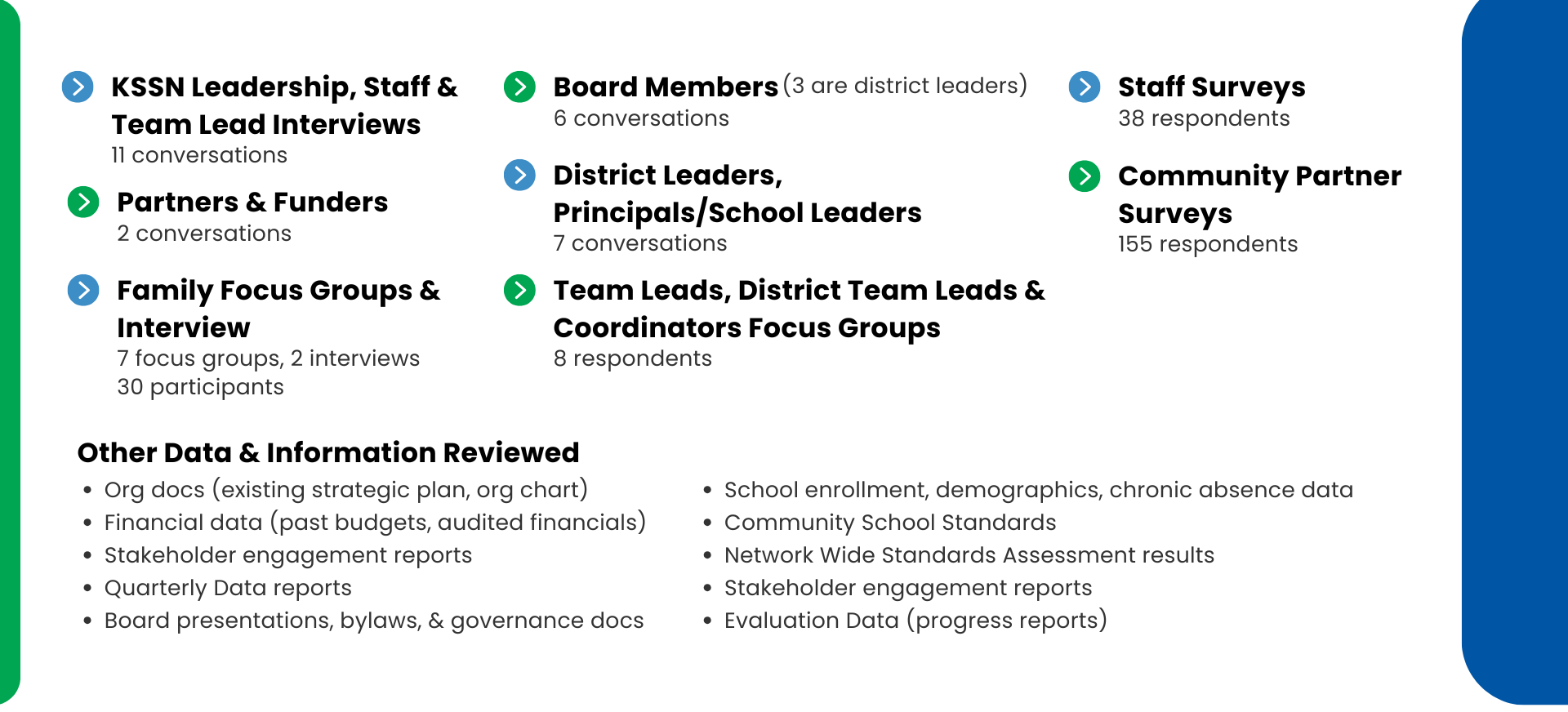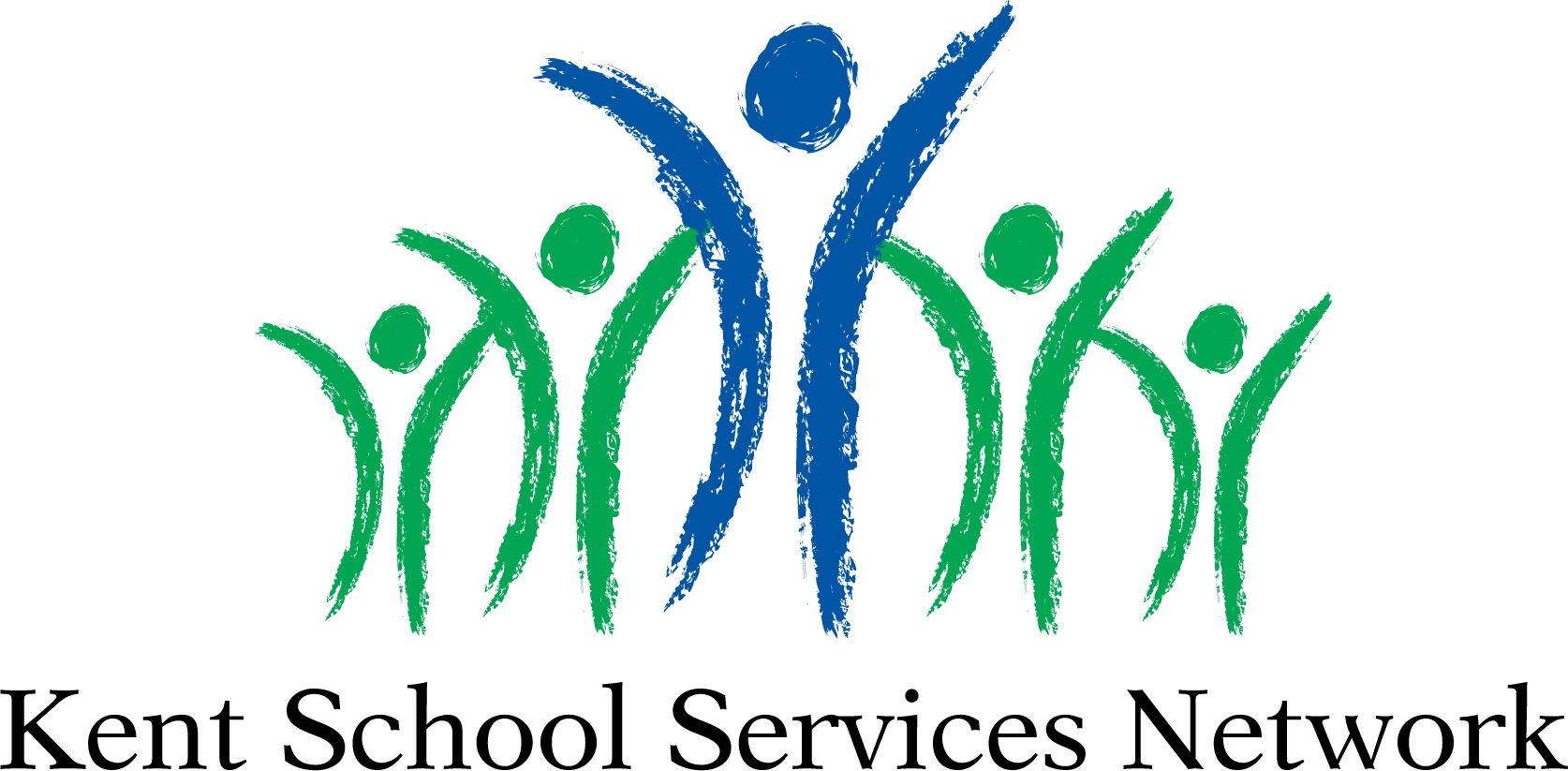By 2028, KSSN will play a lead role in ensuring Kent County’s students and their families thrive in communities that support their overall health and well-being. KSSN will do this by...
Strategic priorities tied to impact goals
Priority 1: Clarify what KSSN does and invest in how it collaborates to maximize partnerships, drive alignment, and deepen impact.
Initiative 1a: Clarify what KSSN does and why.
Develop archetypes of the work aligned to the Essentials for Community School Transformation (i.e., powerful student and family engagement; collaborative leadership/shared power and voice; expanded, enriched learning opportunities; rigorous, community-connected classroom instruction; culture of belonging, safety, care) to serve as both internal guidance/best practice sharing and as a foundation for collaborative planning with partners.
Clarify KSSN's why through iteration of the organization’s mission and vision statements and further clarification of its stated values in action.
Initiative 1b: Invest in how KSSN does its work (internally).
Clarify the roles of KSSN team members with an emphasis on the role of CS coordinator to drive the work outlined in 1a, the role of Team Leaders and the role of KSSN’s leadership team. Define all of these relative to the work of community and school partners.
Develop a team sustainability plan including but not limited to: soliciting and acting upon regular feedback from team members on feelings of sustainability, satisfaction, impact; providing targeted onboarding, professional learning and supportive leadership/mentorship, and collaboration opportunities; implementing a robust recognition and appreciation program.
Move toward market rate compensation for all KSSN roles with an initial priority for CS coordinators, team leaders and which may consider differentiated roles based on size, complexity, etc. of school/district assignment.
Strengthen internal systems including but not limited to data capacity, financial management, partner tracking/stewardship
Initiative 1c: Invest in how KSSN does its work (externally).
Increase KSSN-to-district engagement (e.g., ED to Superintendents, Team Lead to Central Office CS Lead) with a goal to deepen shared understanding of each other’s strategies; agree on shared priorities, goals and ways of working; stay apprised of shifts in context and short-term priorities; plan collaboratively.
Increase KSSN’s role as a convener including: leading communities of practice among district leaders, school leaders, community leaders/partners to deepen understanding of CS strategy as a driver of shared goals; revising purpose and goals of CSLT aligned to school-level needs and priorities.
Regularly solicit and act upon feedback from partners of all types regarding level of satisfaction, sense of impact, opportunities for improvement.
Priority 2: Grow support for KSSN's work among influencers, decision makers, and funders.
Initiative 2a: Extend the reach of KSSN's messaging.
Develop key messages, speaking points as part of a broader branding campaign that connects KSSN’s work to student outcomes and overall community health.
Develop a cadence for regularly and publicly celebrating KSSN’s work, sharing insights learned, spotlighting partnerships, and sharing viewpoints on community current events related to KSSN’s core work.
Engage with school partners and community partners to leverage their platforms to broadcast shared messages to their captive audiences.
Initiative 2b: Develop an advocacy agenda that centers the needs of students and families.
Identify goals and objectives for an advocacy agenda (e.g., resource allocation, changes to policy, etc.) informed by KSSN’s deep knowledge of the needs of students and families, and barriers that exist to meeting those needs.
Build a coalition among KSSN board members, district leaders, school and community partners, students and families to voice aspirations, needs, barriers.
Identify influencers and decision-makers with whom KSSN (i.e., board members, exec. director) will build relationships, and begin strategic outreach.
Identify key decision-points (e.g., budget development), and develop plans to influence decisions that support KSSN’s work.
Initiative 2c: Increase the percentage of KSSN's revenue mix that is made up of foundations and government grants.
Build out KSSN’s internal capacity for proactively pursuing grant-based funding opportunities.
Develop a plan and timeline for pursuing grant opportunities, including:
Identify and pursue federal grant opportunities aligned to CS strategy and KSSN impact goals.
Map local foundations, looking for shared goals; build and steward relationships.
Collaborate with district and school partners to jointly apply for grant funds aligned to shared goals.
Priority 3: Innovate to develop novel approaches to sustainably bring the community school strategy to more students, families.
Initiative 3a: Develop an intentional innovation process, including greenlit criteria and a learning agenda.
Develop a learning agenda for innovation (i.e., what is KSSN trying to learn to do better or differently; how will the innovation help to accelerate progress towards KSSN’s intended impact).
Develop a set of greenlighting criteria for innovation (i.e., how will KSSN decide when it is viable to explore a particular innovation opportunity).
Develop and execute small-scale innovation plans.
Initiative 3b: Invest in and scale promising practices that result from well-executed pilots.
Given outcomes from innovation pilots, determine what practices will be added to KSSN's core business and what, if any, practices will be replaced.
Share learning from the innovation pilot broadly, both internally and externally.

 Click to see a larger version
Skip to end of gallery
Skip to start of gallery
Click to see a larger version
Skip to end of gallery
Skip to start of gallery
 Click to see a larger version
Skip to end of gallery
Skip to start of gallery
Click to see a larger version
Skip to end of gallery
Skip to start of gallery
 Click to see a larger version
Skip to end of gallery
Skip to start of gallery
Click to see a larger version
Skip to end of gallery
Skip to start of gallery
 Click to see a larger version
Skip to end of gallery
Skip to start of gallery
Click to see a larger version
Skip to end of gallery
Skip to start of gallery



